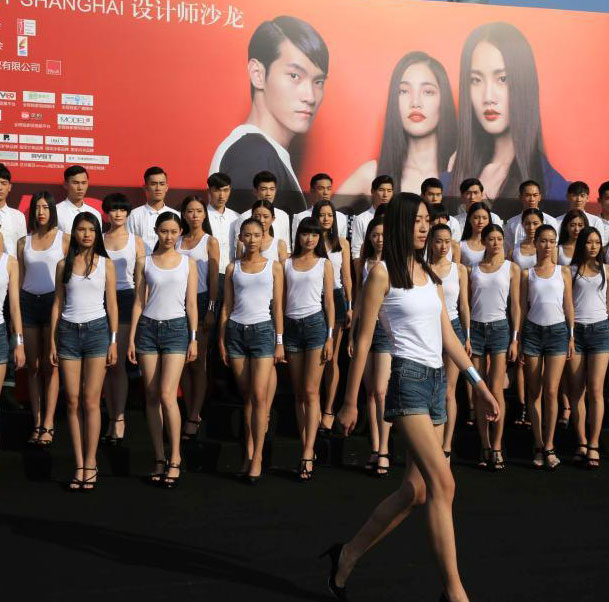 Get off at the last stop — Beijing Subway in vision
Get off at the last stop — Beijing Subway in vision
 Top 100 beauties in the world!
Top 100 beauties in the world!
 Gallery: Who is the most beautiful one?
Gallery: Who is the most beautiful one?
 If you like autumn, put your hands in the air!
If you like autumn, put your hands in the air!
 Fan Bingbing's "Queen style" in new play
Fan Bingbing's "Queen style" in new play
 Lingerie show at 2014 Miss China
Lingerie show at 2014 Miss China
 J-10 fighters show aerobatic stunts in smog-free sky
J-10 fighters show aerobatic stunts in smog-free sky
 Charming contestants of Shanghai Int’l Model Contest
Charming contestants of Shanghai Int’l Model Contest
 Most amazing chi-pao beauties
Most amazing chi-pao beauties
 7 deadly animal attacks
7 deadly animal attacks
SEOUL, Dec. 2-- South Korea's statistical agency last month unveiled the so-called "secondary indicators" to more exactly figure out labor market conditions, from which the " sentiment" jobless rate people actually feel in a real world reached 10.1 percent in October, more than tripling the official figure of 3.2 percent.
The official unemployment rate gauges the percentage of those unemployed who actively sought jobs in the past four weeks to the sum of people employed and unemployed. Public distrust was deep toward the official data as it failed to reflect reality for " strict standards."
The government data has excluded part-time workers who hope to get a regular job working more than 36 hours a week and those who want to work but reply during the job survey period that they conducted no job-searching activity in the past four weeks for illness, housework or other reasons.
The "sentiment" or "real" jobless rate, which includes those incomplete workers and potential job-seekers, topped 10 percent, with the actual number of those unemployed under the eased standards surging to 2.875 million from an official figure of 858, 000 in October. "It is very hard to become a (official) member of those unemployed in Korea (for the strict standards)," a government official said Tuesday on condition of anonymity. The official jobless rate among those aged 15-29 was 8 percent in October.
Reflecting a wide gap in the real and official indicators, a cable-channel drama originating from a webtoon gained a great popularity in South Korea. The dramatized webtoon "Misaeng" features a high-school graduate who gets a job as an intern worker in a big company.
The "Misaeng," which means "unborn" or "uncompleted" in English, won a growing sympathy from office workers as well as frustrated graduates who suffer from falling regular jobs and rising youth unemployment. The webtoon drew 1.1 billion views locally compared with 2.1 billion YouTube views won globally by South Korean rapper Psy's "Gangnam Style."
Working conditions among blue-collar irregular workers were much worse. "Irregular workers are slaves verbatim. Unless you experience it in person, you will never understand it," an irregular employee at a subcontractor of LG Uplus, the country's No. 3 mobile operator, said in an interview with Xinhua Tuesday.
"Whenever irregular workers call for improved working conditions, the company always said we are not a member of the company. It has never offered a full wage, which the company originally promised, citing various reasons, the 37-year-old said, declining to be identified for possible disadvantages.
South Korean President Park Geun-hye has emphasized the creation of "high-quality" jobs since her inauguration. Park said right after being elected president that her administration of state affairs would be centered on employment, stressing the need for creation of high-quality jobs.
Finance Minister Choi Kyung-hwan, however, told reporters on Nov. 25 that over-protecting regular workers and under-protecting irregular workers drove companies to increase irregular workers, raising controversy that he may hint at easing regulations to help companies fire regular workers more freely.
The number of irregular workers increased from 8.23 million in May to 8.52 million in August, according to Korea Labor and Society Institute (KLSI). It indicated about 45 percent of the country's wage earners are working in poor conditions of low wage and job instability.
(For the latest China news, please follow @PDChina on Twitter at http://www.twitter.com/PDChina and @PeoplesDaily on Facebook at http://www.facebook.com/PeoplesDaily)
 HK majority will decide fate of protests
HK majority will decide fate of protests Guangdong officials rob graves to meet monthly cremation targets
Guangdong officials rob graves to meet monthly cremation targets A home for all seasons
A home for all seasons GT Leader Round Table discusses reform and growth
GT Leader Round Table discusses reform and growthDay|Week|Month